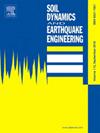IF 4.2
2区 工程技术
Q1 ENGINEERING, GEOLOGICAL
引用次数: 0
摘要
为探讨移动荷载作用下地基梁局部空隙的影响,进行了模型试验,并利用 DIC 技术获得了考虑局部空隙的梁动态响应。然后研究了各种参数对梁响应的影响。此外,利用分离变量法计算了自由振动模式控制方程,并建立了带局部空隙地基梁在移动荷载作用下的动态响应控制方程。然后分析确定了局部空隙地基梁的自由振动频率和模态表达式。接着,应用模态叠加法确定了局部空隙地基梁在移动荷载作用下的稳态响应解析解。通过与实验结果对比,验证了分析模型的准确性。最后,利用分析方程研究了空隙长度、梁的截面弯曲刚度、地基弹性刚度和荷载移动速度对地基梁动态响应的影响。结果表明,地基梁的固有频率直接受截面弯曲刚度、空隙长度和地基刚度的影响,空隙长度也会影响激励频率。当激励频率接近固有频率时,梁的动态响应将迅速增加。此外,即使激振频率与固有频率相差很大,仍会出现高阶共振和抵消现象。空隙长度对梁变形的影响非常显著,当空隙长度与梁厚度的比值从 1.25 增加到 7.5 时,梁的变形将增加 400-500%。提高地基刚度可减轻梁的变形,但当变形达到一定程度(超过 70 兆帕)后,地基刚度的变化对梁变形的影响微乎其微。本文章由计算机程序翻译,如有差异,请以英文原文为准。
Experimental and analytical study on dynamic response of foundation beam with local void under moving load
To explore the influence of local void of foundation beam under moving load, model experiments were carried out, and the dynamic response of beams considering local void was obtained using DIC technology. The impact of various parameters on the response of beams was then examined. In addition, by using the separated variable approach, the free vibration mode control equation was calculated, and the dynamic response control equation of the foundation beam with local void under moving load was established. The locally void foundation beam's free vibration frequency and mode expression were then determined analytically. Next, the mode superposition approach was applied to determine the steady-state response analytical solution of the locally void foundation beam under moving load. The accuracy of the analytical model was verified through comparison with experimental results. Lastly, analytical equations were used to investigate the effects of void length, sectional bending stiffness of the beam, foundation elasticity stiffness, and load movement speed on the dynamic response of foundation beams. The results show that the foundation beam's natural frequency is directly impacted by the sectional flexural stiffness, void length and foundation stiffness, and the void length will also affect the excitation frequency. When the excitation frequency approaches the natural frequency, the dynamic response of the beam will rapidly increase. In addition, even when there is a large difference between the excitation frequency and the natural frequency, high-order resonance and cancellation phenomena still occur. The effect of void length on beam deformation is significant, with a deformation increase of 400–500 % when the ratio of void length to beam thickness increased from 1.25 to 7.5. Raising the foundation's stiffness can lessen the beam's distortion, but after it reaches a certain point (over 70 MPa), changes in the foundation's stiffness have minimal impact on the beam's deformation.
求助全文
通过发布文献求助,成功后即可免费获取论文全文。
去求助
来源期刊

Soil Dynamics and Earthquake Engineering
工程技术-地球科学综合
CiteScore
7.50
自引率
15.00%
发文量
446
审稿时长
8 months
期刊介绍:
The journal aims to encourage and enhance the role of mechanics and other disciplines as they relate to earthquake engineering by providing opportunities for the publication of the work of applied mathematicians, engineers and other applied scientists involved in solving problems closely related to the field of earthquake engineering and geotechnical earthquake engineering.
Emphasis is placed on new concepts and techniques, but case histories will also be published if they enhance the presentation and understanding of new technical concepts.
 求助内容:
求助内容: 应助结果提醒方式:
应助结果提醒方式:


